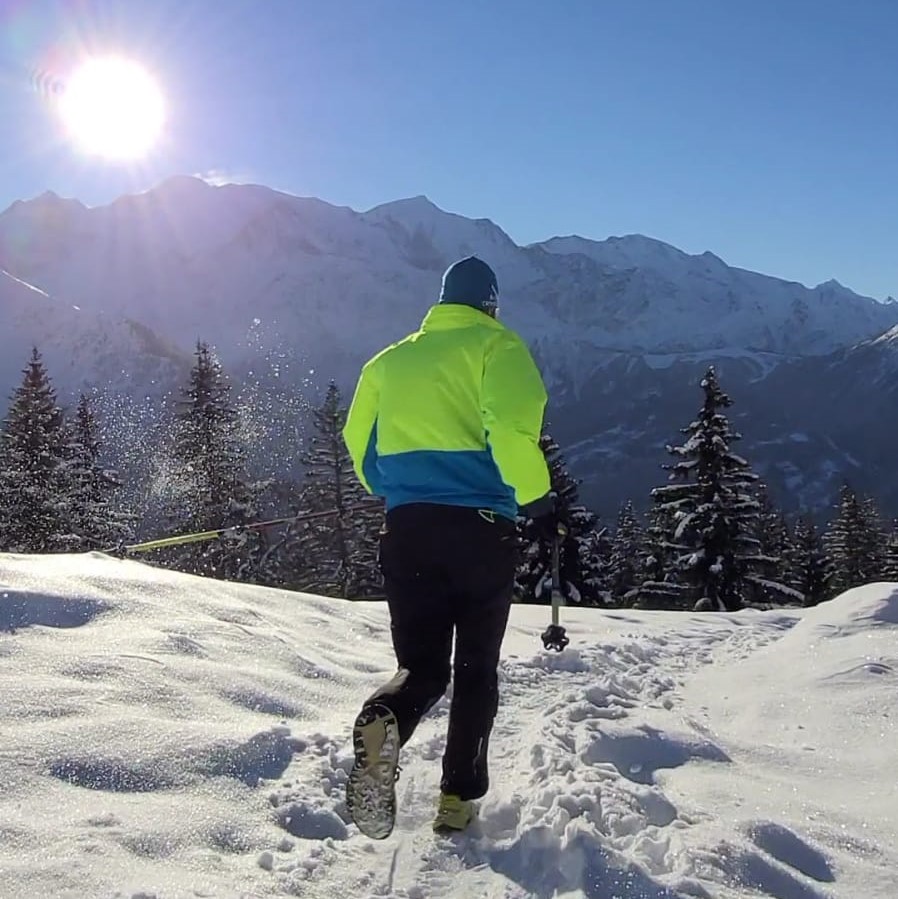White trail: our preparation and equipment advice

In recent years, with the rise of trail running, we have noticed that the bib season does not stop with the first frosts of winter! Indeed, we are seeing more and more snow trails called white trails or snow trail appearing.
Even if it is a trail, therefore a race, the white trail requires specific preparation and equipment. Here are some tips to help you prepare for it as best as possible.
the particularities of the white trail
- Ahigh-altitude race, in the cold
White trails take place in the mountains, in ski resorts, on average above 1000 m altitude and are most often run at night (for short or medium trails).
Distances generally range from 7 to 20 km. The best cover the 10 km in 40 minutes, while the last take up to 2h30-3h.
At altitude, especially at night, fatigue sets in more quickly and you can feel dizzy more quickly. The risk of injury is doubled (especially sprains).
- A tenfold increase in effort
Running 10 km on snow is equivalent to around 16-17 km in classic trail running. That is 1.5 to 1.6 times more effort.
It is a more physical effort, the cardio rises much higher because of the type of terrain, the stress potentially caused by running at night, the cold...
how to prepare for a white trail?
This type of race requires specific preparation since the conditions are very different from classic trail running, in terms of support, weather and biological conditions.
Running in the cold and at night for hours is a big change for the body. It's best to prepare for it.
It's advisable to train by running on snowy terrain to work on your footing. You need to be as light as possible, raising your knees more to get closer to the snow.
Specific proprioception work is also essential to work on footing on different types of terrain and snow (fresh, packed, icy). This can be done indoors or outdoors with scales or physiotherapy equipment.
Also, don't forget to practice running with a headlamp to know where to point your lamp and where to look.
Similarly, it's essential to prepare for a white trail by thinking about nutrition and hydration. The dry mountain air and the cold dry out the body much more quickly. Even if you feel less need to drink than in summer, it is essential to stay well hydrated.
how to equip yourself for a white trail?
how to dress for a white trail?
It is advisable to carefully follow the three-layer system:
- A thermal layer, close to the body, which retains heat and wicks away perspiration.
- A warm, insulating layer.
- A windbreaker or waterproof jacket, which you will wear mainly during the warm-up, or for the first few meters of the race, and then after crossing the finish line. Don't keep it on during the race.
How to eat on a white trail?
Hydration is essential before, during and after exercise because you get dehydrated very quickly in the mountains (cold, dry air, night).
In white trail running, water inevitably tends to freeze or be close to zero, so this can cause thermal shock when drinking it. Also, we advise you to have a flask with water or energy drink at room temperature and another with lukewarm water. So over the kilometers, the water in this second flask will certainly have cooled down but will still be at an acceptable temperature for your body. Also remember to exhale after drinking from the flask so that the teat does not freeze.
Similarly, energy gels can harden in the cold and therefore become difficult to ingest. Therefore, favor solid intakes rather than liquids or add a little very hot water to the gel so that it does not harden too quickly and put the Eco-pocket in a pocket close to the body. This solid intake will depend on your habits and the type of race (distance/elevation ratio in particular).
To learn more about this topic, don't hesitate to consult the article from our sister brand, Authentic Nutrition, specialist in sports nutrition: Running in winter: our hydration and nutrition advice.
what shoes should you wear for a white trail?
Never run on snow with running shoes. Choose trail shoes with strong studs (4-6 mm). You can also attach athletic spikes or trail chains to them, which have the same function as car chains. About 90% of snow trailers are equipped with them.
What poles should be used on a white trail?
In some races, those that take place on cross-country ski trails, the organizers prohibit the use of poles. Then it's a question of habit and individual feeling!
It is obvious that trail poles are a great help on descents to ensure balance. They serve as support and guidance in turns, like skiing.
For a run in powder snow, you should choose poles with wide baskets for better lift.
We see that younger people often run without poles, while those in their thirties, forties and beyond use them more systematically.
> Discover the range of Guidetti trail poles
testimony from fabrice bernede
Living at the foot of the mountains, it's only natural that I practice white trail running, in training or in races.
It's magical to discover landscapes in a completely different light from the rest of the year: immaculate snow, unspoiled places, very few people, nature in all its simplicity. It soothes me to go running in the snow!
Article co-written by Fabrice Bernede, trail ambassador for Team Guidetti Performance, and Aurélie Joubin

